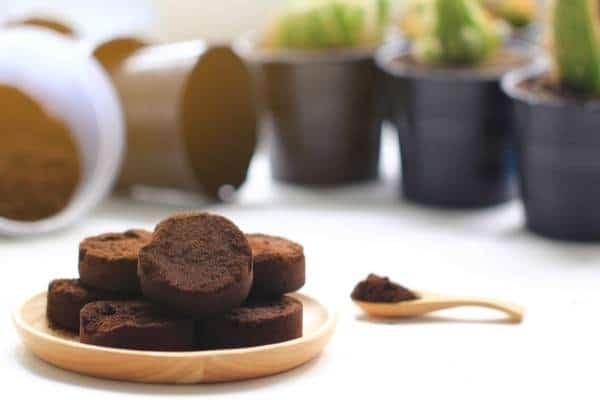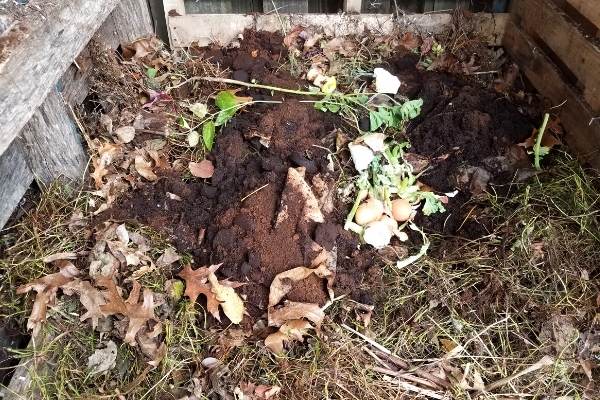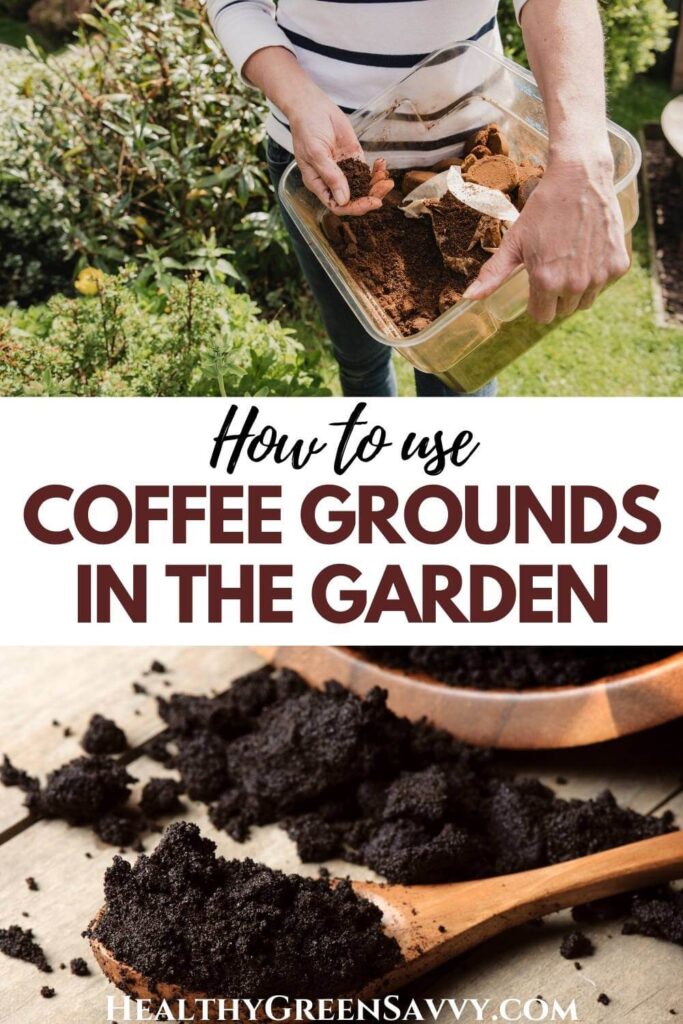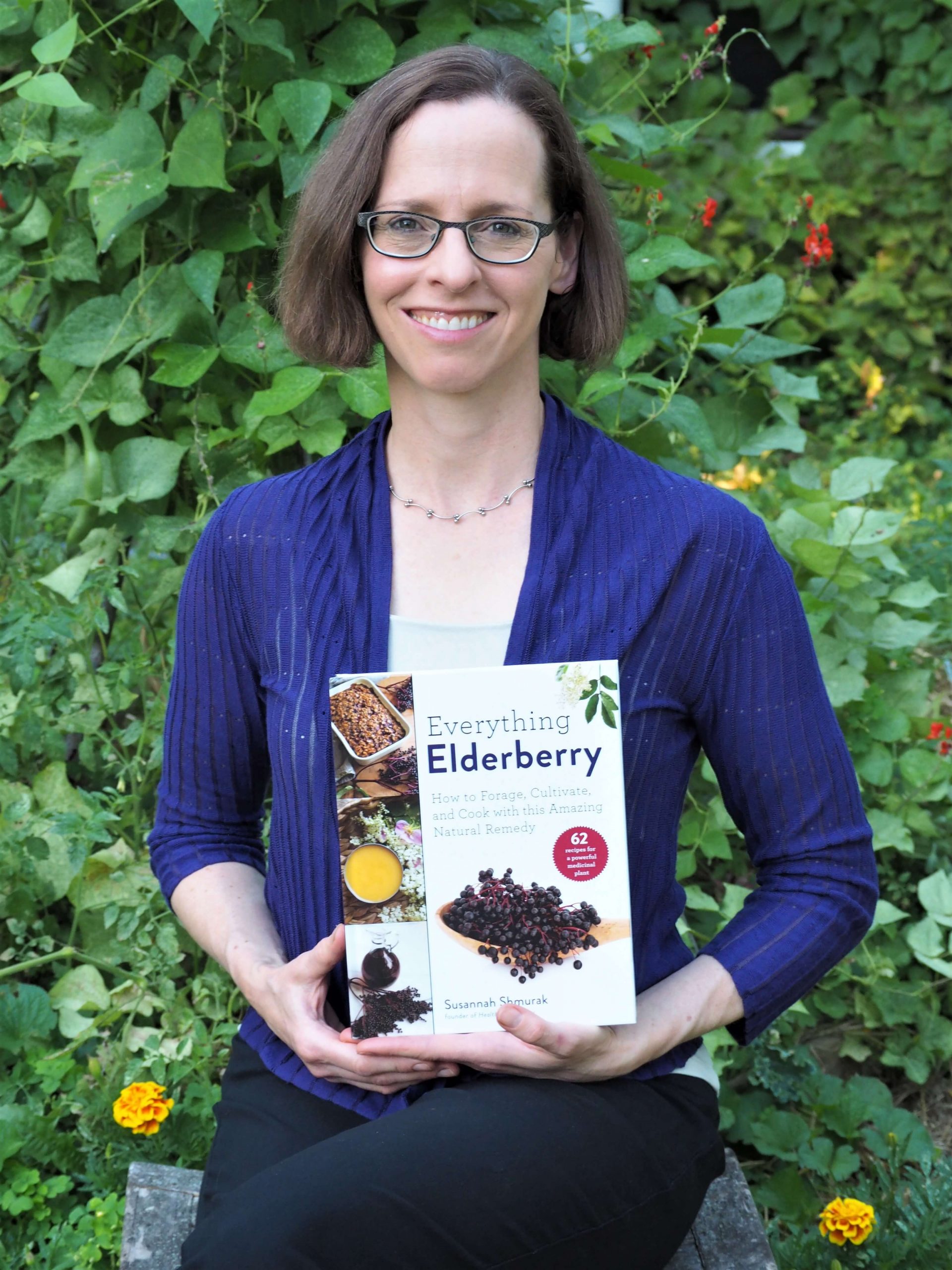Last Updated on February 19, 2024
Did you know that there are dozens of ways for using coffee grounds in the garden and around the house? We covered 35 used coffee grounds uses in a prior post, but it got so long we needed a whole separate post focusing on the best uses for coffee grounds in the garden. There’s a fair amount of confusion about how to use coffee grounds in the garden, so let’s clear that up with some scientific studies pointing us to the best uses for coffee grounds for plants.

HOW TO USE COFFEE GROUNDS IN THE GARDEN: THE BASICS
If you’ve been thinking about using your used coffee grounds for plants, there’s some important information you need to know about using coffee grounds in the garden so you’re helping rather than harming your precious garden plants.
So are coffee grounds good for plants?
Yes and no. Used coffee grounds contain nutrients like potassium, nitrogen, calcium, and small amounts of other minerals that in theory can help feed your plants, whether you put them directly in the garden or compost them first.
However, as is the case with banana peel fertilizer, some of the hype on the internet is overblown, and using coffee grounds in the garden needs to be done with caution.
The problem? The caffeine that remains in used coffee grounds. Caffeine is actually a compound produced by plants to inhibit other plants’ growth, and that’s probably not what you’re after in a plant food!
Caffeine in used coffee grounds: What studies show
Some people wonder whether there’s still caffeine left in spent coffee grounds after we’ve brewed our morning cup of java. Surprisingly, there is. This study shows that used coffee grounds still had 3-8 milligrams of caffeine per gram of coffee.
For this reason, experts advise not placing grounds directly on the soil, as they may inhibit the growth of plants. Adding them to your compost is likely a safer way to use them in the garden, though there’s some evidence that too much coffee in the compost can kill the worms and microbes you want to thrive in your compost bin.
Researchers found better results with the addition of cardboard, a “brown” compost ingredient rather than a “green” one like food scraps, when composting coffee grounds. They recommend you don’t overdo the addition of coffee grounds if you want the healthiest compost for your garden.
Are coffee grounds acidic?
There’s some dispute over whether coffee grounds are acidic or not, largely because the acidity of used coffee grounds can vary. The acids in brewed coffee largely wind up in your cup, and coffee grounds will be only mildly acidic in most cases. The Oregon State University Extension Service reports that used coffee grounds have a pH of 6.5-6.8, pretty close to neutral.
Though some people recommend using coffee grounds on acid-loving plants, once you’ve brewed your coffee, your used coffee grounds won’t do much to alter the pH of your soil.
If you want to use coffee grounds as a plant food for acid-loving plants, you would have to use fresh, not used coffee grounds, which not only means even more caffeine on your plants, but also seems like a pretty expensive and wasteful practice. I would advise using the fresh grounds for yourself and buying a plant food tailored for acid-loving plants.
This simple pH meter can help you determine the pH of your soil and also measures moisture and light exposure.
If you want to experiment with adding coffee grounds directly in the garden anyway, try a light sprinkling on your soil or steep used coffee grounds in water and use the liquid to water plants.
This publication from Washington State University goes into more detail about acidity and using used coffee grounds in the garden.

BEST PRACTICES FOR USING COFFEE GROUNDS IN THE GARDEN
Because of their caffeine content and tendency to compact, the safest way to use coffee grounds in the garden is to add them in moderate amounts to your compost, where they will combine with all your food scraps and yard waste and make a balanced fertilizer.
You’ll probably come across suggestions for using coffee grounds as fertilizer, mulch, and pest repellent though, so let’s explore the pros and cons of using coffee grounds in the garden this way.
USING COFFEE GROUNDS AS FERTILIZER
Because research suggests using coffee grounds directly in the garden inhibits plant growth, garden experts don’t recommend using them in the garden without first composting them.
Though you may see suggestions for using coffee grounds to help scatter small seeds, you’ll likely be inhibiting germination with this practice.
WHICH PLANTS LIKE USED COFFEE GROUNDS?
Because the caffeine in used coffee grounds inhibits germination and growth, avoid using coffee grounds where you’re planning to plant seeds or seedlings. Larger plants, like trees and shrubs may handle coffee grounds better, but it’s still wise to proceed with caution using coffee grounds directly on plants rather than in compost.
Ignore all the advice about using coffee grounds on acid-loving plants, since used coffee grounds aren’t very acidic. Sure, you could use fresh, unused coffee grounds on your rhododendrons and blueberries, but since that’s not only expensive, it adds more caffeine, you won’t be doing those plants any favors.
If you do try adding used coffee grounds to plants, note that coffee grounds are great for retaining moisture, which some plants will like and others won’t. Moisture-loving plants like lily of the valley and marigold might tolerate coffee grounds better than plants that prefer dry soil like lavender and rosemary.
One garden crop to consider using coffee grounds for: Mushrooms, which aren’t plants, actually, but fungi. More on how to use coffee grounds to grow mushrooms below.
GROWING MUSHROOMS ON USED COFFEE GROUNDS
I’m just getting into growing my own mushrooms, and it turns out that a big pile of coffee grounds makes a great substrate for homegrown mushrooms! If you’re curious, here’s more on how to use coffee grounds to grow mushrooms from Mother Earth News.
If you want to try using coffee grounds for growing mushrooms, you’ll need to get some mushroom spawn. If you’re a total beginner, growing your first mushrooms with a foolproof grow kit might be a better route.
USING COFFEE GROUNDS AS MULCH
Because coffee grounds tend to compact, a thick layer of coffee grounds as mulch that some sources recommend may be counterproductive in the garden. In addition to the caffeine you’ll be adding, that hard barrier won’t allow water to penetrate, and your plants’ roots won’t get the moisture they need.
If you’re using coffee grounds around your plants, spread sparingly and mix in with the soil so they don’t create a hard barrier that moisture can’t penetrate.
USING COFFEE GROUNDS IN COMPOST
Hopefully, you haven’t been putting those valuable used coffee grounds in the trash but adding them to your compost pile, where they contribute loads of good stuff your garden plants can use. One study even found that compost that included large amounts of used coffee grounds produced lower amounts of greenhouse gas than other compost.
One of the reasons compost is so beneficial for plants is that it contains a balance of nutrients plants need. Don’t go overboard adding coffee grounds to your compost pile (like adding numerous sacks from your local coffee shop), as there’s some evidence chemicals in coffee grounds may actually harm the worm and microbe population, which you want thriving in your compost pile.
Because of the potential problems applying coffee grounds in large amounts to the garden, in general composting them first is considered best for your plants.

FEED USED COFFEE GROUNDS TO YOUR WORMS
Have a vermicomposter? Your worms will love to munch on used coffee grounds. Researchers found that the end product (i.e., worm poop or “castings”) is richer in nutrients when coffee is included in their chow.
USING COFFEE GROUNDS TO REPEL PESTS
Several pests dislike the smell or texture of coffee grounds or are harmed by their caffeine content.
Coffee grounds have been shown to repel slugs, so a perimeter of coffee grounds may preserve your lettuce plants from these destructive critters.
Anecdotally, some people have found that coffee grounds spread in a perimeter around a house can help keep away ants.
Putting coffee grounds around the border of your garden may also help deter neighborhood cats from using your garden as a litter box. They may also help repel rabbits and squirrels. Reapply regularly, as the coffee grounds will lose their repellent odor in a week or two.
You can also burn dried coffee grounds like a citronella candle to repel mosquitoes.
–>Need other natural pest control options?
Here’s what to know about how to get rid of Japanese beetles and squash vine borers, and here’s a useful natural mosquito control method.
Asian jumping worms are an increasingly common problem home gardeners face. Here’s what know about Asian jumping worms vs. earthworms so you can be prepared if you find these invasive pests in your garden. As it happens, when they invade, your first tip-off may be soil that looks like coffee grounds in your garden!
USING COFFEE GROUNDS IN THE GARDEN TO CONTROL WEEDS
So by now you’ve probably gathered that putting used coffee grounds directly on plants might not be a great idea if your aim is to help them grow.
But what about those plants you’d like to kill off?
Smothering them with coffee grounds might do the trick. If you have an area in need of weed control and a surplus of coffee grounds, you can try spreading coffee grounds there and see if it inhibits growth and germination or forms an impenetrable barrier, killing weeds you don’t want.
Just don’t forget that many weeds are both edible and delicious, and harvest those rather than trying to kill them with coffee.
Here are some top weeds you can eat to try harvesting from your garden this season.
ONE LAST WAY TO USE COFFEE GROUNDS IN THE GARDEN: AS TRACTION ON ICE
If you’re worried about harming garden plants with your coffee grounds or have extra lying around in winter, you can use them in place of sand to offer a little traction on icy patches.
HOW TO STORE USED COFFEE GROUNDS FOR GARDENING
If you’re a gardener, you may find that you want more coffee grounds than you can produce yourself. Many coffee shops offer used coffee grounds bagged for gardeners to use.
Be aware that since used coffee grounds contain a fair amount of moisture, if you’re not putting them directly in your garden or compost, you can’t simply leave them in a bag or container or they’ll grow mold.
Until you’re ready to use coffee grounds in the garden, you can store smaller amounts in the refrigerator. For larger amounts, you’ll want to dry them, either in the sun or in the oven.
To dry coffee grounds in the sun:
Spread coffee grounds on newspapers in layers 1-2 inches thick and place in a sunny area. Turn the grounds daily to allow them to dry completely.
Take them to a sheltered place if rain is expected.
To dry coffee grounds in the oven:
Spread coffee grounds in a thin layer on cookie sheets and place in an oven heated to its lowest temperature (about 180 degrees for most ovens).
Turn off the heat and leave the coffee grounds to dry.
When the oven starts to cool, stir coffee grounds to expose wetter ones to heat and turn the oven back on, turning it off when it’s reached 180 degrees.
Repeat steps above until the coffee grounds have dried completely, then store in an airtight container till ready for use.
Do you use coffee grounds in the garden? What’s worked for you?
Save this info on using coffee grounds in the garden for later!

Using coffee grounds in the garden photo credits: DGLimages, Justin Smith, Monthira Yodtiwong, NorGal

Susannah is a proud garden geek and energy nerd who loves healthy food and natural remedies. Her work has appeared in Mother Earth Living, Ensia, Northern Gardener, Sierra, and on numerous websites. Her first book, Everything Elderberry, released in September 2020 and has been a #1 new release in holistic medicine, naturopathy, herb gardening, and other categories. Find out more and grab your copy here.



 Hi, I'm Susannah, a garden geek, energy nerd, and fan of healthy food and natural remedies. Need some simple, practical solutions for living healthier and greener? You've come to the right place! More about me and my green projects
Hi, I'm Susannah, a garden geek, energy nerd, and fan of healthy food and natural remedies. Need some simple, practical solutions for living healthier and greener? You've come to the right place! More about me and my green projects
Leave a Reply